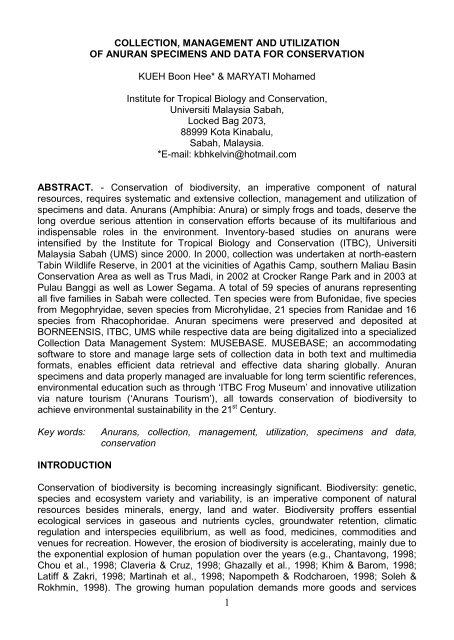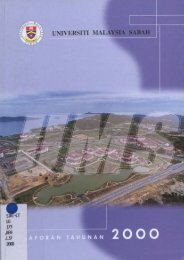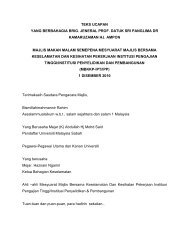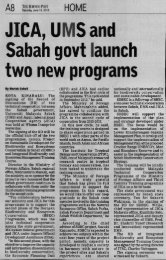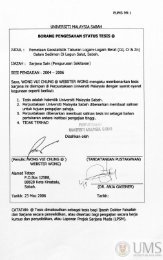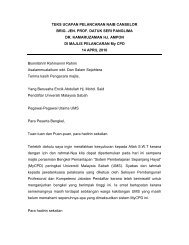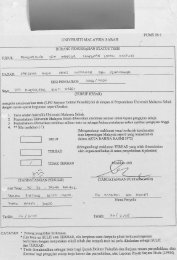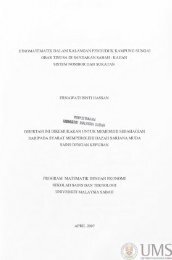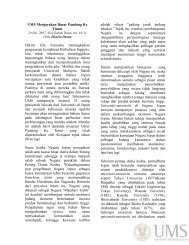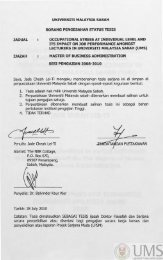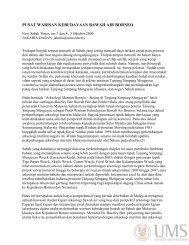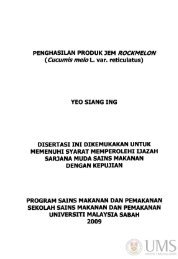collection, management and utilization - UMS - Universiti Malaysia ...
collection, management and utilization - UMS - Universiti Malaysia ...
collection, management and utilization - UMS - Universiti Malaysia ...
Create successful ePaper yourself
Turn your PDF publications into a flip-book with our unique Google optimized e-Paper software.
COLLECTION, MANAGEMENT AND UTILIZATION<br />
OF ANURAN SPECIMENS AND DATA FOR CONSERVATION<br />
KUEH Boon Hee* & MARYATI Mohamed<br />
Institute for Tropical Biology <strong>and</strong> Conservation,<br />
<strong>Universiti</strong> <strong>Malaysia</strong> Sabah,<br />
Locked Bag 2073,<br />
88999 Kota Kinabalu,<br />
Sabah, <strong>Malaysia</strong>.<br />
*E-mail: kbhkelvin@hotmail.com<br />
ABSTRACT. - Conservation of biodiversity, an imperative component of natural<br />
resources, requires systematic <strong>and</strong> extensive <strong>collection</strong>, <strong>management</strong> <strong>and</strong> <strong>utilization</strong> of<br />
specimens <strong>and</strong> data. Anurans (Amphibia: Anura) or simply frogs <strong>and</strong> toads, deserve the<br />
long overdue serious attention in conservation efforts because of its multifarious <strong>and</strong><br />
indispensable roles in the environment. Inventory-based studies on anurans were<br />
intensified by the Institute for Tropical Biology <strong>and</strong> Conservation (ITBC), <strong>Universiti</strong><br />
<strong>Malaysia</strong> Sabah (<strong>UMS</strong>) since 2000. In 2000, <strong>collection</strong> was undertaken at north-eastern<br />
Tabin Wildlife Reserve, in 2001 at the vicinities of Agathis Camp, southern Maliau Basin<br />
Conservation Area as well as Trus Madi, in 2002 at Crocker Range Park <strong>and</strong> in 2003 at<br />
Pulau Banggi as well as Lower Segama. A total of 59 species of anurans representing<br />
all five families in Sabah were collected. Ten species were from Bufonidae, five species<br />
from Megophryidae, seven species from Microhylidae, 21 species from Ranidae <strong>and</strong> 16<br />
species from Rhacophoridae. Anuran specimens were preserved <strong>and</strong> deposited at<br />
BORNEENSIS, ITBC, <strong>UMS</strong> while respective data are being digitalized into a specialized<br />
Collection Data Management System: MUSEBASE. MUSEBASE; an accommodating<br />
software to store <strong>and</strong> manage large sets of <strong>collection</strong> data in both text <strong>and</strong> multimedia<br />
formats, enables efficient data retrieval <strong>and</strong> effective data sharing globally. Anuran<br />
specimens <strong>and</strong> data properly managed are invaluable for long term scientific references,<br />
environmental education such as through ‘ITBC Frog Museum’ <strong>and</strong> innovative <strong>utilization</strong><br />
via nature tourism (‘Anurans Tourism’), all towards conservation of biodiversity to<br />
achieve environmental sustainability in the 21 st Century.<br />
Key words:<br />
Anurans, <strong>collection</strong>, <strong>management</strong>, <strong>utilization</strong>, specimens <strong>and</strong> data,<br />
conservation<br />
INTRODUCTION<br />
Conservation of biodiversity is becoming increasingly significant. Biodiversity: genetic,<br />
species <strong>and</strong> ecosystem variety <strong>and</strong> variability, is an imperative component of natural<br />
resources besides minerals, energy, l<strong>and</strong> <strong>and</strong> water. Biodiversity proffers essential<br />
ecological services in gaseous <strong>and</strong> nutrients cycles, groundwater retention, climatic<br />
regulation <strong>and</strong> interspecies equilibrium, as well as food, medicines, commodities <strong>and</strong><br />
venues for recreation. However, the erosion of biodiversity is accelerating, mainly due to<br />
the exponential explosion of human population over the years (e.g., Chantavong, 1998;<br />
Chou et al., 1998; Claveria & Cruz, 1998; Ghazally et al., 1998; Khim & Barom, 1998;<br />
Latiff & Zakri, 1998; Martinah et al., 1998; Napompeth & Rodcharoen, 1998; Soleh &<br />
Rokhmin, 1998). The growing human population dem<strong>and</strong>s more goods <strong>and</strong> services<br />
1
esides basic needs <strong>and</strong> hence, putting more pressure on the already overwhelmed<br />
biodiversity. Eventually, such a phenomenon shall dictate the destruction of humans too.<br />
Conservation of biodiversity requires systematic <strong>and</strong> extensive <strong>collection</strong>,<br />
<strong>management</strong> <strong>and</strong> <strong>utilization</strong> of biological specimens <strong>and</strong> data. Feasible conservation<br />
has to be substantiated by comprehension of the composition of biodiversity that<br />
prescribes the best strategies (e.g., Stuebing, 1998; Stuebing & Wong, 2000; Inger,<br />
2003; Ng, 2005) for restoration, maintenance, monitoring <strong>and</strong> sustainable usages.<br />
ANURANS<br />
Anurans (Amphibia: Anura) are tailless amphibians or simply frogs <strong>and</strong> toads.<br />
Depending on the vertebrae, anurans in Borneo are categorized into six families, namely<br />
Bombinatoridae, Bufonidae, Megophryidae, Microhylidae, Ranidae <strong>and</strong> Rhacophoridae.<br />
Presently, there are 32 genera <strong>and</strong> approximately 150 species. Close to 100 species<br />
can be found in Sabah.<br />
Anurans deserve the long overdue serious attention in conservation efforts<br />
because of the multifarious <strong>and</strong> indispensable roles in the environment. Anurans form a<br />
crucial part of environmental food webs. Being herbivores feeding on microscopic plants<br />
<strong>and</strong> fungi as tadpoles, except for Hoplobatrachus rugulosus that is known to feed on<br />
other tadpoles too (Inger & Stuebing, 1997), <strong>and</strong> carnivores feeding largely on ants,<br />
termites, invertebrates <strong>and</strong> even other anurans, small lizards, small crustaceans, small<br />
snakes, small birds <strong>and</strong> small mammals, anurans become primary, secondary <strong>and</strong><br />
tertiary users. The niche as predators of insects <strong>and</strong> invertebrates also enables anurans<br />
to be biological control agents for agricultural pests. This anuran-man relationship<br />
reduces the dependence of planters on chemical pesticides which pollute <strong>and</strong> kill the<br />
environment. Anurans are good bioindicators to indicate environmental health as well.<br />
Anurans possess permeable skin for water to travel freely from both directions for water<br />
intake <strong>and</strong> keeping the skin moist for breathing. Such a characteristic, coupled with the<br />
semi-aquatic lifestyle, make anurans capable of detecting the slightest existence of<br />
pollutants in water sources causing abnormality <strong>and</strong> total disappearance.<br />
COLLECTION OF ANURAN SPECIMENS AND DATA<br />
(A)<br />
Collection of anuran specimens<br />
The <strong>collection</strong> of anuran specimens through inventory-based studies were intensified by<br />
Institute for Tropical Biology <strong>and</strong> Conservation (ITBC), <strong>Universiti</strong> <strong>Malaysia</strong> Sabah (<strong>UMS</strong>)<br />
since 2000. The inventory-based studies were undertaken during various scientific<br />
expeditions organized by ITBC as <strong>UMS</strong>’ centre of excellence on terrestrial biology. ITBC<br />
was set up on 1 st June 1996 as Tropical Biology <strong>and</strong> Conservation Unit <strong>and</strong> upgraded to<br />
an institute on 1 st June 1999. In June 2000, ITBC registered her second postgraduate<br />
student researching on anurans who studied the application of biogeographical data of<br />
anurans for conservation area prioritization in Borneo by using WORLDMAP<br />
Programme (Kueh, 2003) <strong>and</strong> in July 2003, employed the student as her first<br />
herpetologist upon his convocation.<br />
In 2000, <strong>collection</strong> was undertaken at north-eastern Tabin Wildlife Reserve on<br />
16<br />
th – 22 nd October 2000 for seven nights during the wet season. A total of 14 species<br />
were recorded from four families (Kueh & Maryati, 2003) as shown in Table 1. A new<br />
addition to the anuran inventory of the wildlife reserve was made during the <strong>collection</strong>:<br />
2
Metaphrynella sundana (Kueh & Maryati, 2003; Kueh, 2005). This secretive species is<br />
endemic to Borneo.<br />
In 2001, <strong>collection</strong>s were conducted at Agathis Camp, southern edge of Maliau<br />
Basin Conservation Area, <strong>and</strong> Trus Madi. At Agathis Camp, <strong>collection</strong> was done on 12 th<br />
– 14 th May 2001 for three nights <strong>and</strong> sampled eight species from three families (Kueh &<br />
Maryati, 2005) (Table 1). Seven of the species are endemic to Borneo. At Trus Madi,<br />
<strong>collection</strong> carried out on 30 th October – 4 th November 2001 for five nights recorded 11<br />
species representing five families (Kueh, 2004a) (Table 1). Eight of the species are<br />
endemic to Borneo with two which are endemic to Sabah, namely Philautus bunitus <strong>and</strong><br />
Rhacophorus angulirostris.<br />
th<br />
The following year, <strong>collection</strong> was undertaken at Crocker Range Park on 26<br />
August – 12 th September 2002 <strong>and</strong> amassed specimens from 46 species (excluding<br />
unidentified species) <strong>and</strong> five families (Kueh et al., 2004) (Table 1). The number of<br />
species collected was the largest ever from a single <strong>collection</strong> by ITBC. Besides, the<br />
<strong>collection</strong> added 16 new locality records to the inventory of the park (Kueh, 2005).<br />
In 2003, premier <strong>collection</strong>s were carried out for Pulau Banggi <strong>and</strong> Lower<br />
Segama. At the former locality, <strong>collection</strong> was done on 25<br />
th July – 2 nd August 2003. Six<br />
species representing three families were sampled (Kueh, in press) (Table 1). Two<br />
species: Microhyla borneensis <strong>and</strong> Limnonectes leporinus, are endemic to Borneo. At<br />
the latter locality, <strong>collection</strong> was conducted on 17 th – 26 th September 2003 for 10 nights.<br />
A total of 15 species from three families were sampled (Kueh & Yambun, in press)<br />
(Table 1). Two species are endemic to Borneo, namely Microhyla borneensis <strong>and</strong><br />
Rhacophorus harrissoni.<br />
Accumulatively, 59 species representing all five families in Sabah were recorded<br />
from the <strong>collection</strong>s (Table 1). Ten species were from Bufonidae, five species from<br />
Megophryidae, seven species from Microhylidae, 21 species from Ranidae <strong>and</strong> 16<br />
species from Rhacophoridae. The percentage of representation of the total species for<br />
each family by the number of species sampled varies from 26.3% to 53.8% (Fig. 1).<br />
Hence, the number of species sampled represents approximately 39% of the currently<br />
described species in Borneo.<br />
(B)<br />
Collection of anuran data<br />
Data on the specimens were yielded during <strong>collection</strong>s <strong>and</strong> recorded manually. Manual<br />
records are without the risk of being spoiled in the field as compared to electronic <strong>and</strong><br />
digital versions <strong>and</strong> therefore, preferred (Matsui, 2003). Specimens are only half of its<br />
value without proper records that hold crucial data (Kueh, 2004b). These data are<br />
scientific name, family, date of <strong>collection</strong>, locality (name <strong>and</strong> GPS coordinate), altitude,<br />
microhabitat where the specimen was sampled, behaviour of the anuran when located,<br />
method of <strong>collection</strong>, snout-vent length (SVL), weight, collector, identifier, specimen<br />
number (BORNEENSIS number) <strong>and</strong> notes (for miscellaneous data such as the<br />
vernacular name, development stage, known ethnozoological usages <strong>and</strong> identification<br />
features).<br />
Besides text data, multimedia data are imperative as well. Photographs, video<br />
footages <strong>and</strong> audio recordings are utmost useful to record, especially the colour of the<br />
specimens before preservation, anuran postures, anuran pupils (colour, size <strong>and</strong> shape),<br />
localities (habitats <strong>and</strong> microhabitats) <strong>and</strong> anuran calls.<br />
3
MANAGEMENT OF ANURAN SPECIMENS AND DATA<br />
(A)<br />
BORNEENSIS<br />
Anuran specimens collected were preserved in 70% ethanol as wet specimens <strong>and</strong><br />
deposited in the Vertebrate Collection Room, BORNEENSIS. BORNEENSIS is the<br />
reference <strong>collection</strong> centre for ITBC which gather <strong>and</strong> store dead <strong>and</strong> live specimens as<br />
well as related data of Bornean biodiversity, particularly from Sabah (Maryati & Mohd.<br />
Fairus, 1998; Ahmad & Maryati, 1999). Besides anurans, BORNEENSIS houses<br />
specimens of lower plants, invertebrates <strong>and</strong> other vertebrates in four <strong>collection</strong> rooms.<br />
Shouldering two of the major onuses that are to promote the importance of taxonomy in<br />
conservation <strong>and</strong> build up of local <strong>and</strong> regional capacity in taxonomy, BORNEENSIS is<br />
anticipated to preponderate both in specimens <strong>and</strong> data <strong>collection</strong> as well as national<br />
<strong>and</strong> international recognition as a centre for biosystematics <strong>and</strong> taxonomy. Inevitably,<br />
BORNEENSIS has been <strong>and</strong> shall always be a pride of ITBC, but is for all who strive for<br />
biodiversity conservation.<br />
(B)<br />
MUSEBASE<br />
Text <strong>and</strong> multimedia data of anurans are being digitalized into a specialized Collection<br />
Data Management System: MUSEBASE, at ITBC. MUSEBASE is a software specially<br />
developed by Fujitsu (Japan) for ITBC <strong>and</strong> acquired via Japan International Cooperation<br />
Agency (JICA) under the ‘Bornean Biodiversity <strong>and</strong> Ecosystems Conservation (BBEC)<br />
Programme in Sabah, <strong>Malaysia</strong>’. The software is a modification of MUSETHEQUE that<br />
is widely used by museums <strong>and</strong> galleries in Japan. With the installation of four licenses<br />
at ITBC on 5 th September 2003, MUSEBASE, a brainchild of the second author as the<br />
Director of ITBC cum Head of Research <strong>and</strong> Education Component under the BBEC<br />
Programme, was made ready to be utilized <strong>and</strong> entrusted to the coordination under the<br />
first author as MUSEBASE Project Manager.<br />
MUSEBASE is an accommodating software to store <strong>and</strong> manage large sets of<br />
<strong>collection</strong> data for efficient data retrieval <strong>and</strong> effective data sharing globally. Data are<br />
registered through user-friendly Collection Data Registration procedures. Pre-existing or<br />
new data in Excel format can be uploaded into MUSEBASE too by converting the data<br />
into a Comma Separated Value (CSV) file. Multiple multimedia data can be registered<br />
for a single registration. All data digitalized are stored in a Database Server. The entire<br />
database is searchable but only by permitted personnel as set by the institution under<br />
the User Authority Management. Therefore, data are definitely secured from<br />
unscrupulous parties even from the same institution. Thus far ITBC has digitalized about<br />
17,000 data into MUSEBASE. Specimen labels <strong>and</strong> barcodes are automatically<br />
produced by the software for each registration to replace h<strong>and</strong>-written labels <strong>and</strong> for<br />
convenient data retrieval for every specimen by simply scanning respective barcode.<br />
Various reports on daily, weekly, monthly or yearly data registration <strong>and</strong> total data<br />
registration can be prepared by the software through its Statistics Management <strong>and</strong><br />
printed out either in HTML or PDF format.<br />
MUSEBASE is also furnished with Schedule Management <strong>and</strong> Lending<br />
Management operations. Schedule Management assists users to plan <strong>and</strong> monitor the<br />
<strong>utilization</strong> of specimens within own institution while Lending Management deals with<br />
lending of specimens to other institutions. Both functions allow users to record the<br />
purpose, date, duration <strong>and</strong> venue of specimen <strong>utilization</strong> as well as the personnel <strong>and</strong><br />
4
institution concerned. Reminders can be pre-prepared <strong>and</strong> sent to the decided<br />
recipient(s) on pre-determined date by e-mails.<br />
As for data sharing, the software comes with Web Site Management. A web site<br />
is automatically generated by the software to display authorized data through a Web<br />
Server. The display of data is strictly in adherence with the permission granted by each<br />
user through the Release Flag application. Data given the limited status during<br />
registration absolutely do not appear in the web site while those indicated as unlimited<br />
are viewable in the internet. The data are searchable in the Collection Search page via<br />
three methods: simple, detailed <strong>and</strong> classified search. The other pages of the web site<br />
are News, Museum Info, What’s New, Floor Plans, Feedback, Site Map <strong>and</strong> URL Links.<br />
The web site address for ITBC MUSEBASE is http://itbcmuse.ums.edu.my.<br />
UTILIZATION OF ANURAN SPECIMENS AND DATA<br />
Anuran specimens <strong>and</strong> data collected <strong>and</strong> properly managed are invaluable for<br />
numerous <strong>utilization</strong>s towards biodiversity conservation. Three types of <strong>utilization</strong> are<br />
highlighted in this paper, namely for scientific references, environmental education (EE)<br />
<strong>and</strong> ‘Anurans Tourism’. These <strong>utilization</strong>s aim to proffer holistic conservation approach<br />
encompassing the scientific community, general public, local people <strong>and</strong> international<br />
society.<br />
Anuran specimens <strong>and</strong> data, similarly for any other biological specimens <strong>and</strong><br />
data, are immensely needed for long term scientific references in a wide spectrum of<br />
researches <strong>and</strong> conservation area <strong>management</strong>. These range from researches on<br />
taxonomy <strong>and</strong> biogeography to molecular biology <strong>and</strong> biodiversity advancement as well<br />
as from conservation area prioritization to the enforcement of conservation area <strong>and</strong><br />
wildlife <strong>management</strong> legislations. Even under the present progression of DNA<br />
technologies, genetic knowledge must be complemented with specimens that bear<br />
morphological <strong>and</strong> anatomical information as well as text <strong>and</strong> multimedia data which<br />
record the ethological, ethnobiological <strong>and</strong> habitat information.<br />
At ITBC, anuran specimens <strong>and</strong> data have been utilized for the prioritization of<br />
conservation areas (Kueh, 2003). A 24-month research was conducted on Borneo by<br />
using WORLDMAP Programme (Version IV) aimed at identifying new conservation<br />
priority areas based on high species richness <strong>and</strong> range-size rarity, irreplaceability<br />
(near-minimum sets) <strong>and</strong> Gap Analyses in order to synergize the ‘know-hows’ of<br />
conservation with the ‘know-where’. A total of 139 biogeographical data of anurans were<br />
digitalized into WORLDMAP Programme to reveal four suggested new conservation<br />
priority areas: Tubau <strong>and</strong> Sungai Mengiong in Sarawak as well as Sanggau <strong>and</strong> Kubu in<br />
West Kalimantan.<br />
Currently, ethnozoological research is being undertaken to document traditional<br />
usages of anurans as a source of food <strong>and</strong> medicines that conduces the survivability of<br />
traditional knowledge <strong>and</strong> enhances the blooming alternative treatment sector. The<br />
ripple effect galvanizes more of the general public <strong>and</strong> local people to conserve anurans<br />
<strong>and</strong> the habitats due to the realization of the scientific, economic, social, cultural <strong>and</strong><br />
health boons of anurans. The research not only utilizes anuran specimens <strong>and</strong> data at<br />
ITBC, but also augments the <strong>collection</strong>.<br />
Anuran specimens <strong>and</strong> data are also being utilized for EE via ‘ITBC Frog<br />
Museum’. As another brainchild of the second author, ‘ITBC Frog Museum’ was<br />
launched on 14 th December 2003 <strong>and</strong> entrusted to the coordination under the first author<br />
as Museum Manager (I). The museum aims to make aware <strong>and</strong> educate the general<br />
local public <strong>and</strong> international visitors on the biology <strong>and</strong> importance of anurans. Threats<br />
5
on the survival of anurans are exposed too to inspire visitors to love <strong>and</strong> subsequently,<br />
participate in the conservation of anurans <strong>and</strong> the habitats. The museum is a<br />
combination of anuran specimens, models, dioramas, touch screens, video show,<br />
information <strong>and</strong> data, publications <strong>and</strong> children craftworks.<br />
Lastly is a rather unorthodox genre of <strong>utilization</strong> of anuran specimens <strong>and</strong> data<br />
which is for ‘Anurans Tourism’. Nature tourism, an industry worth billions, has long been<br />
regarded as a practical contemporary remedy for the erosion of biodiversity <strong>and</strong><br />
deterioration of the environment (e.g., Ceballos-Lascuráin, 1996). Nature tourism<br />
generates revenues to propel economic development <strong>and</strong> existing conservation efforts<br />
<strong>and</strong> at the same time, lures people from all over the globe to appreciate the biodiversity<br />
<strong>and</strong> environment to the extent that it initiates even more conservation efforts. ‘Anurans<br />
Tourism’ means ‘responsible travel to relatively undisturbed natural areas with the<br />
intension to see, admire, enjoy <strong>and</strong> learn about anurans, including the relationships with<br />
humans in the past <strong>and</strong> at present, that eventually conserves anurans <strong>and</strong> the<br />
environment as well as sustains the well being of local people’ (Kueh, 2004c). The<br />
definition captivates the descriptive <strong>and</strong> prescriptive components which comply with the<br />
definitions of both nature tourism <strong>and</strong> ecotourism provided by World Tourism<br />
Organization (WTO) <strong>and</strong> The International Ecotourism Society (TIES). Anuran<br />
specimens <strong>and</strong> data are utilized to prospect potential species <strong>and</strong> sites to be promoted<br />
under this new nature tourism product.<br />
CONCLUSION<br />
Conservation of biodiversity is turning more <strong>and</strong> more pertinent due to rapid erosion of<br />
biodiversity with systemic repercussions. Conservation of biodiversity requires<br />
systematic <strong>and</strong> extensive <strong>collection</strong>, <strong>management</strong> <strong>and</strong> <strong>utilization</strong> of anurans, organism<br />
group with multifarious <strong>and</strong> indispensable roles in the environment, specimens <strong>and</strong> data.<br />
Inventory-based studies on anurans were intensified by ITBC, <strong>UMS</strong> since 2000. A total<br />
of 59 species from all five families in Sabah were collected, preserved as wet specimens<br />
in BORNEENSIS <strong>and</strong> with data being stored in <strong>and</strong> managed by MUSEBASE. Anuran<br />
specimens <strong>and</strong> data have been <strong>and</strong> are being utilized for several undertakings: scientific<br />
references for researches, EE via ‘ITBC Frog Museum’ <strong>and</strong> ‘Anurans Tourism’, all<br />
towards conservation of biodiversity to achieve environmental sustainability in the 21 st<br />
Century.<br />
ACKNOWLEDGEMENTS<br />
The authors are grateful to <strong>Universiti</strong> <strong>Malaysia</strong> Sabah (<strong>UMS</strong>) for allowing this paper to<br />
be presented at the ‘International Conference on Natural Resources <strong>and</strong> Environmental<br />
Management 2005’. Gratitude goes to various people <strong>and</strong> organizations that enabled<br />
<strong>collection</strong>s to be done at Tabin Wildlife Reserve, Maliau Basin Conservation Area, Trus<br />
Madi, Crocker Range Park, Pulau Banggi <strong>and</strong> Lower Segama. Cordial appreciation to<br />
Lucy Kimsui who curates the anuran specimens at BORNEENSIS, Institute for Tropical<br />
Biology <strong>and</strong> Conservation (ITBC), <strong>UMS</strong>. Special thanks to Japan International<br />
Cooperation Agency (JICA) which sponsored MUSEBASE under the ‘Bornean<br />
Biodiversity <strong>and</strong> Ecosystems Conservation (BBEC) Programme in Sabah, <strong>Malaysia</strong>’.<br />
6
REFERENCES<br />
AHMAD S. & M., MARYATI. 1999. BORNEENSIS entomological <strong>collection</strong>. In:<br />
Proceedings Of The Third Entoma Seminar 1999. Pp. 39 – 41.<br />
CEBALLOS-LASCURÁIN, H. 1996. Tourism, Ecotourism And Protected Areas: The<br />
State Of Nature-Based Tourism Around The World And Guidelines For Its<br />
Development. Gl<strong>and</strong>: IUCN.<br />
CHANTAVONG, S. 1998. Environmental <strong>and</strong> biodiversity conservation in Lao PDR. In:<br />
Biodiversity Conservation In ASEAN: Emerging Issues & Regional Needs. I.,<br />
GHAZALLY & M., MURTEDZA (Eds.). London: ASEAN Academic Press Ltd. Pp.<br />
128 – 137.<br />
CHOU L.M., B.P.L., GOH & T.J., LAM. 1998 Environmental protection <strong>and</strong> biodiversity<br />
conservation in Singapore. In: Biodiversity Conservation In ASEAN: Emerging<br />
Issues & Regional Needs. I., GHAZALLY & M., MURTEDZA (Eds.). London:<br />
ASEAN Academic Press Ltd. Pp. 214 – 232.<br />
CLAVERIA, F.G. & R.D. CRUZ. 1998. Environmental <strong>and</strong> biodiversity conservation in<br />
the Philippines. In: Biodiversity Conservation In ASEAN: Emerging Issues &<br />
Regional Needs. I., GHAZALLY & M., MURTEDZA (Eds.). London: ASEAN<br />
Academic Press Ltd. Pp. 187 – 213.<br />
GHAZALLY I., N. PILCHER, S. OAKLEY, M., MURTEDZA & A., LAMRI. 1998. Marine<br />
biodiversity conservation in Sabah: Moving past the rhetorical stages. In:<br />
Biodiversity Conservation In ASEAN: Emerging Issues & Regional Needs. I.,<br />
GHAZALLY & M., MURTEDZA (Eds.). London: ASEAN Academic Press Ltd. Pp.<br />
165 – 186.<br />
INGER, R.F. 2003. Sampling biodiversity in Bornean frogs. The Natural History Journal<br />
of Chulalongkorn University. 3(1) 9 – 15.<br />
INGER, R.F. & R.B. STUEBING. 1997. A Field Guide To The Frogs Of Borneo. Kota<br />
Kinabalu: Natural History Publications (Borneo) Sdn. Bhd.<br />
KHIM, L. & N. BAROM. 1998. Current issues on biodiversity conservation in Cambodia.<br />
In: Biodiversity Conservation In ASEAN: Emerging Issues & Regional Needs. I.,<br />
GHAZALLY & M., MURTEDZA (Eds.). London: ASEAN Academic Press Ltd. Pp.<br />
78 – 95.<br />
KUEH B.H. 2003. Application of biogeographical data of frogs to prioritize conservation<br />
areas in Borneo. Unpublished M.Sc. Thesis. Kota Kinabalu: <strong>Universiti</strong> <strong>Malaysia</strong><br />
Sabah.<br />
KUEH B.H. 2004a. Diversity of anurans at Trus Madi, Sabah. In: Herpetology And The<br />
Future: Proceedings Of The ‘International Conference On Bornean Herpetology<br />
2003’. M., MARYATI, M. MATSUI & B.H., KUEH (Eds.). Kota Kinabalu: Institute<br />
for Tropical Biology <strong>and</strong> Conservation. Pp. 26 – 29.<br />
7
KUEH B.H. 2004b. Conservation biology: Sampling <strong>and</strong> preservation methods for<br />
anurans. Paper presented at Ecological Methodology in Conservation Biology<br />
(EMCB) Course II 2004, Sabah, <strong>Malaysia</strong>, 23 rd September 2004.<br />
KUEH B.H. 2004c. The new marketable face of nature tourism: Anurans. In:<br />
Contemporary Topics In Tropical Biology And Conservation Research In Borneo:<br />
Proceedings Of Research Seminars At Institute For Tropical Biology And<br />
Conservation, <strong>Universiti</strong> <strong>Malaysia</strong> Sabah From October 2002 To March 2004. M.,<br />
MARYATI, S., MONICA, F., ARMAN HADI & T. TACHI (Eds.). Kota Kinabalu:<br />
Institute for Tropical Biology <strong>and</strong> Conservation. Pp. 146 – 149.<br />
KUEH B.H. 2005. New anuran records by ITBC for two conservation areas in Sabah:<br />
Tabin Wildlife Reserve <strong>and</strong> Crocker Range Park. In: ITBC Newsletter. Issue<br />
1/2004. Kota Kinabalu: Institute for Tropical Biology <strong>and</strong> Conservation. Pp. 18 –<br />
19.<br />
KUEH B.H. In press. Anurans of Pulau Banggi, Sabah. In: Tun Mustapha Park Scientific<br />
Expedition Monograph.<br />
KUEH B.H., S., AHMAD, M. MATSUI & M., MARYATI. 2004. Notes on the anurans of<br />
Crocker Range Park. In: Crocker Range Scientific Expedition 2002. M., MARYATI,<br />
H., ZULHAZMAN, T. TACHI & N., JAMILI (Eds.). Kota Kinabalu: <strong>Universiti</strong><br />
<strong>Malaysia</strong> Sabah. Pp. 103 – 112.<br />
KUEH B.H. & M., MARYATI. 2003. Notes on the anurans of north-eastern Tabin Wildlife<br />
Reserve. In: Tabin Limestone Scientific Expedition 2000. M., MARYATI, M.<br />
SCHILTHUIZEN & A., MAHEDI (Eds.). Kota Kinabalu: <strong>Universiti</strong> <strong>Malaysia</strong> Sabah.<br />
Pp. 139 – 143.<br />
KUEH B.H. & M., MARYATI. 2005. Anurans of protected areas in Sabah: Tabin Wildlife<br />
Reserve, Crocker Range Park <strong>and</strong> Maliau Basin Conservation Area. In: Wallace<br />
In Sarawak – 150 Years Later: Proceedings Of An International Conference On<br />
Biogeography And Biodiversity. A.A. TUEN & I. DAS (Eds.). Kota Samarahan:<br />
Institute of Biodiversity <strong>and</strong> Environmental Conservation. Pp. 182 – 187.<br />
KUEH B.H. & P.I. YAMBUN. In press. Herpetofauna of Lower Segama, S<strong>and</strong>akan,<br />
Sabah. In: Lower Segama Scientific Expedition Monograph.<br />
LATIFF A. & A.H., ZAKRI. 1998. Environmental <strong>and</strong> conservation issues in <strong>Malaysia</strong>. In:<br />
Biodiversity Conservation In ASEAN: Emerging Issues & Regional Needs. I.,<br />
GHAZALLY & M., MURTEDZA (Eds.). London: ASEAN Academic Press Ltd. Pp.<br />
138 – 164.<br />
MARTINAH B.H.T., B.H.I., NORALINDA & B.H.M.Y., JAMALLUDIN. 1998.<br />
Environmental issues <strong>and</strong> conservation strategies in Brunei Darussalam. In:<br />
Biodiversity Conservation In ASEAN: Emerging Issues & Regional Needs. I.,<br />
GHAZALLY & M., MURTEDZA (Eds.). London: ASEAN Academic Press Ltd. Pp.<br />
65 – 77.<br />
8
MARYATI M. & J., MOHD. FAIRUS. 1998. The BORNEENSIS <strong>collection</strong>: For whom <strong>and</strong><br />
for what Paper presented at Sabah Interagency Tropical Ecosystem (SITE)<br />
Research Seminar III, Sabah, <strong>Malaysia</strong>, 26 th – 27 th August 1998.<br />
MATSUI, M. 2003. Collecting <strong>and</strong> preserving amphibians. In: Inventory & Collection:<br />
Total Protocol For Underst<strong>and</strong>ing Of Biodiversity. Y. HASHIMOTO & R.,<br />
HOMATHEVI (Eds.). Kota Kinabalu: Institute for Tropical Biology <strong>and</strong><br />
Conservation. Pp. 229 – 235.<br />
NAPOMPETH, B. & J. RODCHAROEN. 1998. Environmental <strong>and</strong> biodiversity issues in<br />
Thail<strong>and</strong>. In: Biodiversity Conservation In ASEAN: Emerging Issues & Regional<br />
Needs. I., GHAZALLY & M., MURTEDZA (Eds.). London: ASEAN Academic<br />
Press Ltd. Pp. 233 – 246.<br />
NG, P.K.L. 2005. Taxonomy <strong>and</strong> conservation: A perspective from freshwater crabs. In:<br />
Wallace In Sarawak – 150 Years Later: Proceedings Of An International<br />
Conference On Biogeography And Biodiversity. A.A. TUEN & I. DAS (Eds.). Kota<br />
Samarahan: Institute of Biodiversity <strong>and</strong> Environmental Conservation. Pp. 153 –<br />
161.<br />
SOLEH S. & D., ROKHMIN. 1998. Sustainable use of national resources <strong>and</strong><br />
biodiversity conservation in Indonesia. In: Biodiversity Conservation In ASEAN:<br />
Emerging Issues & Regional Needs. I., GHAZALLY & M., MURTEDZA (Eds.).<br />
London: ASEAN Academic Press Ltd. Pp. 96 – 127.<br />
STUEBING, R.B. 1998. Faunal collecting in Southeast Asia: Fundamental need or blood<br />
sport The Raffles Bulletin of Zoology. 46(1) 1 – 10.<br />
STUEBING, R.B. & A. WONG. 2000. The role of the Sabah’s zoological <strong>collection</strong>s in<br />
the conservation of protected areas in Sabah. Paper presented at the International<br />
Conference on In-Situ <strong>and</strong> Ex-Situ Biodiversity Conservation in the New<br />
Millennium, Sabah, <strong>Malaysia</strong>, 19 th – 22 nd June 2000.<br />
9
TABLE 1. Collection of anuran specimens <strong>and</strong> data by Institute for Tropical Biology <strong>and</strong><br />
Conservation (ITBC), <strong>Universiti</strong> <strong>Malaysia</strong> Sabah (<strong>UMS</strong>) since 2000.<br />
(I) Family BUFONIDAE<br />
(1.) Ansonia hanitschi<br />
Inger<br />
(2.) Ansonia leptopus<br />
(Günther)<br />
(3.) Ansonia longidigita<br />
Inger<br />
(4.) Ansonia platysoma<br />
Inger<br />
(5.) Ansonia spinulifer<br />
(Mocquard)<br />
(6.) Bufo divergens<br />
Peters<br />
(7.) Bufo juxtasper<br />
Inger<br />
(8.) Leptophryne<br />
borbonica (Tschudi)<br />
(9.) Pedostibes hosii<br />
(Boulenger)<br />
(10.) Pedostibes<br />
maculatus<br />
(Mocquard)<br />
Tabin<br />
Wildlife<br />
Reserve<br />
<br />
Agathis<br />
Camp<br />
<br />
<br />
<br />
Trus<br />
Madi<br />
<br />
<br />
Crocker<br />
Range<br />
Park<br />
<br />
<br />
<br />
<br />
<br />
<br />
<br />
Pulau<br />
Banggi<br />
Lower<br />
Segama<br />
(II) Family<br />
MEGOPHRYIDAE<br />
(11.) Leptobrachella<br />
baluensis Smith<br />
(12.) Leptobrachella<br />
parva Dring<br />
(13.) Leptobrachium<br />
montanum Fischer<br />
(14.) Leptolalax dringi<br />
Dubois<br />
(15.) Megophrys nasuta<br />
(Schlegel)<br />
<br />
<br />
<br />
<br />
<br />
<br />
(III) Family<br />
MICROHYLIDAE<br />
(16.) Chaperina fusca<br />
Mocquard<br />
(17.) Kalophrynus<br />
heterochirus<br />
Boulenger<br />
(18.) Kalophrynus<br />
pleurostigma<br />
Tschudi<br />
<br />
<br />
<br />
<br />
10
(19.) Kaloula baleata<br />
(Müller)<br />
(20.) Metaphrynella<br />
sundana (Peters)<br />
(21.) Microhyla<br />
berdmorei (Blyth)<br />
(22.) Microhyla<br />
borneensis Parker<br />
<br />
<br />
<br />
<br />
<br />
(IV) Family RANIDAE<br />
(23.) Fejervarya<br />
limnocharis<br />
(Gravenhorst)<br />
(24.) Ingerana baluensis<br />
(Boulenger)<br />
(25.) Limnonectes finchi<br />
(Inger)<br />
(26.) Limnonectes ingeri<br />
(Kiew)<br />
(27.) Limnonectes kuhlii<br />
(Tschudi)<br />
(28.) Limnonectes<br />
leporinus<br />
(Andersson)<br />
(29.) Limnonectes<br />
malesianus (Kiew)<br />
(30.) Limnonectes<br />
palavanensis<br />
(Boulenger)<br />
(31.) Meristogenys<br />
kinabaluensis<br />
(Inger)<br />
(32.) Meristogenys<br />
orpnochemis<br />
(Matsui)<br />
(33.) Occidozyga<br />
baluensis<br />
(Boulenger)<br />
(34.) Occidozyga laevis<br />
(Günther)<br />
(35.) Rana chalconota<br />
(Schlegel)<br />
(36.) Rana erythraea<br />
(Schlegel)<br />
(37.) Rana gl<strong>and</strong>ulosa<br />
Boulenger<br />
(38.) Rana luctuosa<br />
(Peters)<br />
(39.) Rana nicobariensis<br />
(Stoliczka)<br />
(40.) Rana picturata<br />
Boulenger<br />
<br />
<br />
<br />
<br />
<br />
<br />
<br />
<br />
<br />
<br />
<br />
<br />
<br />
<br />
<br />
<br />
<br />
<br />
<br />
<br />
<br />
<br />
11
(41.) Staurois<br />
latopalmatus<br />
(Boulenger)<br />
(42.) Staurois natator<br />
(Günther)<br />
(43.) Staurois<br />
tuberilinguis<br />
Boulenger<br />
<br />
<br />
<br />
(V) Family<br />
RHACOPHORUS<br />
(44.) Nyctixalus pictus<br />
<br />
<br />
(Peters)<br />
(45.) Philautus<br />
<br />
aurantium Inger<br />
(46.) Philautus bunitus<br />
<br />
Inger, Stuebing &<br />
Tan<br />
(47.) Philautus hosii<br />
<br />
(Boulenger)<br />
(48.) Philautus mjöbergi<br />
<br />
Smith<br />
(49.) Philautus petersi<br />
<br />
(Boulenger)<br />
(50.) Polypedates<br />
<br />
leucomystax<br />
(Gravenhorst)<br />
(51.) Polypedates<br />
<br />
<br />
macrotis<br />
(Boulenger)<br />
(52.) Polypedates<br />
<br />
<br />
otilophus<br />
(Boulenger)<br />
(53.) Rhacophorus<br />
<br />
angulirostris Ahl<br />
(54.) Rhacophorus<br />
<br />
appendiculatus<br />
(Günther)<br />
(55.) Rhacophorus<br />
<br />
<br />
dulitensis<br />
Boulenger<br />
(56.) Rhacophorus<br />
<br />
everetti Boulenger<br />
(57.) Rhacophorus<br />
<br />
gauni (Inger)<br />
(58.) Rhacophorus<br />
<br />
<br />
harrissoni Inger &<br />
Haile<br />
(59.) Rhacophorus<br />
<br />
pardalis Günther<br />
Total Species 14 8 11 46 6 15<br />
12
60<br />
50<br />
53.8<br />
47.1<br />
Percentage<br />
(%)<br />
40<br />
30<br />
34.5<br />
26.3<br />
35<br />
20<br />
10<br />
0<br />
BUFONIDAE<br />
MEGOPHRYIDAE<br />
MICROHYLIDAE<br />
RANIDAE<br />
RHACOPHORIDAE<br />
Family<br />
FIGURE 1. Percentage of representation of the total species for each anuran family by<br />
the number of species sampled.<br />
13


